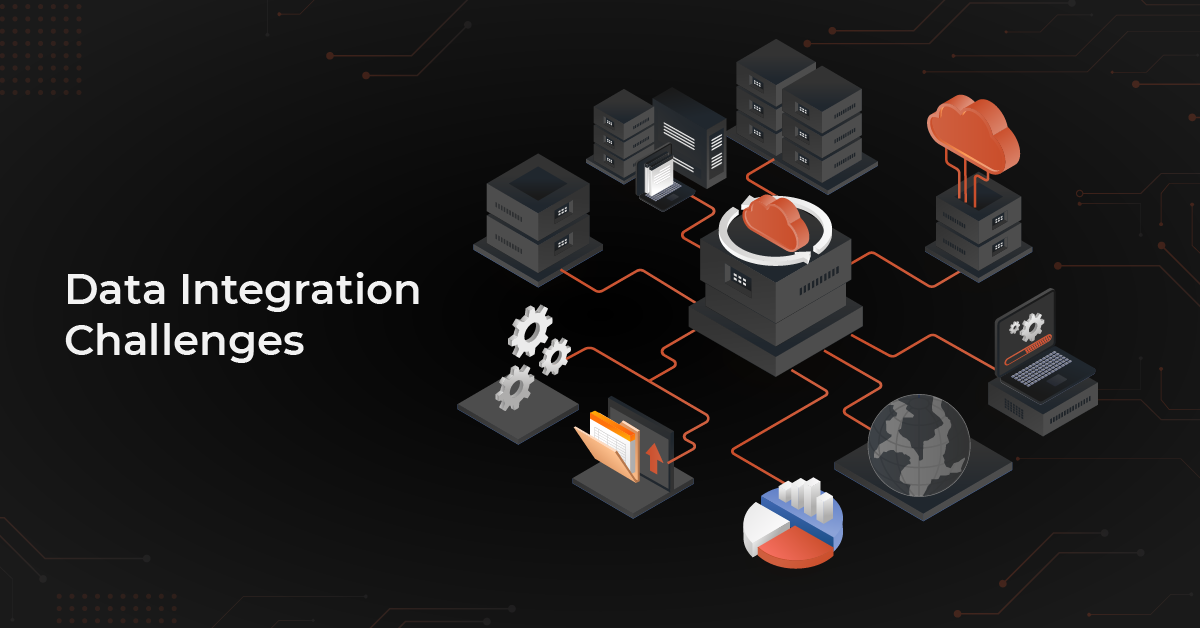Facing a data integration challenge means there’s a significant barrier to getting a grip on how your data integration works and the results it produces. It’s like a hurdle that keeps you from having a clear, unified view of all your different data.
Overcoming these obstacles with the help of a smart data integration platform is key to managing your data more effectively and improving how your organization uses valuable information.
Contents
Major Data Integration Challenges and Solutions
Let’s look at various challenges companies face when it comes to data integration: Also have a look at Best Data integration Consultants data integration vs application integration Data Integration as a Service (DIaaS) to understand more about integrations
#1 Challenge – Multiple Data Sources
- Dealing with diverse data sources can be tricky.
- Organizations obtain information from diverse applications, systems, and databases, leading to data silos.
- Inconsistent formats and structures across various sources complicate integration.
- Handling different data types requires tailored solutions; no one-size-fits-all approach.
Solution – Choose the Right Data Integration Tool
Selecting the right integration software is crucial to avoid multiple data sources. Answer these questions before choosing:
- What data needs integration?
- What is the expected output of your data integration?
- Which applications require integration and how?
- What is the preferred data flow—one-way or two-way?
- Is real-time sync or trigger-action data push needed?
Explore in-app integrations, native tool integrations, or third-party Integration Platform as a Service (iPaaS) providers like DCKAP Integrator, Zapier, Cleo Integration Cloud. Tailor your choice to your specific needs, considering factors like data type and flow frequency.
#2 Challenge – Data Silos
- Data stuck in one place hampers team efficiency.
- Data silos, accessible only to specific departments, hinder collaboration.
- Clear plans for data placement and updates are crucial to prevent information isolation.
Solution – Centralize Data
- Store all corporate data into a cloud-based data warehouse or data lake.
- Grant easy access to individuals or groups while maintaining privacy and security.
- Efficient and accurate data integration is crucial for preventing future data silos.
- Centralize data access and control through a data governance framework.
- Implement robust data access policies.
Additionally, document integration processes meticulously and catalog integrated data. This supports both business users and data scientists in finding the relevant information. As data integration complexity grows, detailed documentation becomes an investment in future ease of use, data recovery, and high availability.
#3 Challenge – Poor Quality Data
- Poor data quality leads to inaccurate data analytics.
- Analytics from invalid or incompatible data can lead to misleading decisions.
- Challenges include replication of data, consolidation into a single platform, and time-consuming processes.
- Once integrations are established, operations run smoothly for efficient data collection.
Solution – Optimize Your Data
Before embarking on data integration, ensure your data is in prime condition. Follow these steps:
- Utilize deduplication tools like Dedupely to clean up duplicates.
- Scan for outdated or invalid data, addressing common problems like bounced emails or invalid phone numbers.
- Optimize data collection channels by removing unnecessary fields in forms and ensuring compliance with data protection policies like GDPR (General Data Protection Regulation).
Cleaning up your databases might be time-consuming, but it’s a one-time effort that enhances data quality, setting the stage for effective integration.
#4 Challenge – Large Data Volumes:
- Dealing with large data volumes may require a lot of resources.
- Storing data is affordable, but integrating and managing data quality in vast amounts can be complex.
- Matching values in large data sets can use up system resources and be slow.
- Operations like aggregating and sorting large amounts of data demand significant resources.
Solution – Manage and Maintain your Data
While data integration aids data management, ongoing oversight is vital. Regularly check databases to ensure operational efficiency, confirm team adherence to protocols, assess tool performance, and update your strategy as needed. As your business grows, your data integration strategy should evolve accordingly.
- Leverage cloud platforms that provide scalable and elastic resources.
- Train team members on proper data input and maintenance procedures across various departments. This reduces low-quality, outdated, or duplicate data in the system.
- Utilize distributed computing frameworks like Apache Hadoop or Apache Spark.
- Distributes processing across multiple nodes, managing large volumes efficiently.
Also read: ERP Data Integration With Other Systems
#5 Challenge – Different Data Formats:
- Businesses collect data in various formats (CSV, Excel, JSON).
- Storing the same information in different formats leads to storage costs, financial losses, and inconsistent data.
- Different data formats are stored differently, whether on-premises or in the cloud.
- Unstructured data is challenging to define, expands exponentially and unpredictably.
- Data in different formats is difficult to query, edit, retrieve, and integrate.
Solution – Structure Your Data
- Standardize data formats across the organization.
- Utilize data integration tools that support various file formats.
- Implement data transformation processes to convert diverse formats into a unified structure.
#6 Challenge – Delays in Data Delivery
- Delays in delivering data pose challenges for real-time data processing.
- Real-time data collection is challenging, especially for personalized e-commerce ads.
- Relying on manual data collection in real-time is impractical due to resource constraints.
Solution – Adapt a Quicker Solution
- Utilize a platform capable of leveraging trigger events, such as a lead filling out a form.
- Triggered events initiate corresponding actions across apps, employees, and data in or near real-time.
- Implement automated data integration tools to solve the speed challenge.
- These tools efficiently collect data in real-time, preventing the waste of valuable enterprise resources.
#7 Challenge – Data Security Concerns:
- Increased risk of security breaches and cyber-attacks as businesses gather more data.
- Involvement of multiple stakeholders introduces the risk of insider threats to data security and privacy.
- Crucial to maintain trust with customers and stakeholders during the integration process.
- Coordinating data ownership and sharing agreements, especially with external sources, is complex.
Solution – Monitor and Implement Data Security Practices
- Choose Data integration Platforms that offers end-to-end data security solutions.
- Implement real-time monitoring to detect and prevent unauthorized access.
- Utilize advanced data masking techniques (tokenization, encryption) for PII protection.
- Regularly audit and update protection measures to align with evolving security standards.
- Implement processes for ensuring compliance with data protection regulations.
Also read: CRM Data Integration: How It Works With Other Systems
Best Data Integration Solution for Distributors – DCKAP Integrator
DCKAP Integrator is a powerful tool for distributors. It is a cloud-based Integration Platform as a Service (iPaaS). This versatile data integration solution seamlessly connects various business systems, such as ERP, CRM, and ecommerce platforms, including Oracle ERP, Netsuite, Microsoft Dynamics 365, SAP Business One, and Salesforce.
This ERP Integration tool ensures a smooth data flow, synchronizing all systems and minimizing data discrepancies. Manual data entry becomes obsolete, resulting in time savings, reduced errors, and decreased reliance on constant developer assistance.
Here is why it is the best choice for you:
- Connect and integrate data seamlessly, breaking down silos between different business systems, ensuring a unified view of information.
- Retrieve high-quality, consistent, and standardized data from various sources, ensuring data integrity and reliability.
- Gain access to real-time insights, allowing for up-to-the-minute analysis and making better business decisions.
- Leverage robust automation capabilities to streamline workflows, reducing manual efforts and enhancing operational efficiency,
- Scale your data integration efforts effortlessly, adapting to the changing needs of your business without compromising performance.
- Equip your teams with accurate and timely data, empowering them to make informed decisions that drive business success.
- Enhance data accuracy across your organization, fostering improved communication and collaboration among teams.
- Enjoy a user-friendly interface and intuitive design, making it easy for users to navigate and utilize the full potential of the integration tool.
DCKAP Integrator stands out with its flexible pricing models, tailored to suit businesses of all sizes.
Discover the perfect plan for your organization! Click here to explore our pricing options and take the first step towards enhancing your data integration journey.
FAQS
What is data integration, and what kind of apps can be integrated?
Data integration involves combining and unifying data from different sources to provide a comprehensive view. Various software applications can be integrated, including ERP systems, CRM (customer relationship management) platforms, ecommerce solutions, and more. There are different platforms for data integration, ranging from traditional ETL (Extract, Transform, Load) tools to modern cloud-based Integration Platform as a Service (iPaaS) solutions.
What are the top data integration challenges?
The most common data integration challenges include dealing with data of various formats, ensuring data quality, managing large volumes of data, addressing security and privacy concerns, and overcoming issues related to data silos and disparate sources.
What is the ultimate goal of data integration?
The ultimate goal of data integration is to provide a unified, accurate, and real-time view of data across an organization. This enables seamless information flow, better decision-making, and improved operational efficiency, ultimately enhancing business operations.
What are common use cases for data integration challenges?
Data integration issues often arise in scenarios involving merging information from different sources, streamlining workflows, and ensuring consistency across different systems.
Is Data Integration a Viable Solution for Outdated Data Formats?
Yes, data integration tools can handle the transformation of data from outdated formats used by legacy systems into more contemporary and standardized formats for improved accessibility and usability.
How does data integration impact customer satisfaction?
Seamless data integration positively influences customer satisfaction by ensuring accurate, timely information delivery, leading to an enhanced customer experience.
What role do data pipelines play in addressing integration challenges?
Data pipelines act as conduits for smooth data flow, connecting disparate systems and facilitating the seamless transfer of information, mitigating integration challenges.
What considerations are crucial when selecting a data integration tool for use cases?
When choosing a tool, factors like adaptability to various data structures, scalability, and support for automated workflows are essential to effectively address diverse use cases.
How does data integration address challenges pose by unstructured data?
Data integration involves careful planning and employs techniques like machine learning to structure and integrate unstructured data, ensuring it can be effectively utilized for business intelligence purposes.
Can data integration tools handle big data from disparate sources?
Yes, modern data integration tools for business intelligence are designed to handle a growing volume of data from diverse sources, leveraging artificial intelligence to streamline the integration process.
How is data ingestion different from traditional methods in data integration?
Data ingestion, often driven by artificial intelligence, involves the automated collection and transfer of raw data, providing a more efficient alternative to traditional data integration methods.




